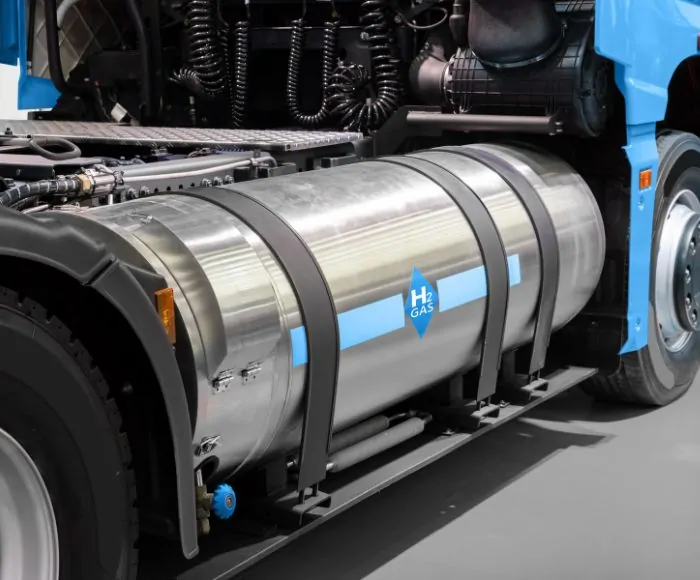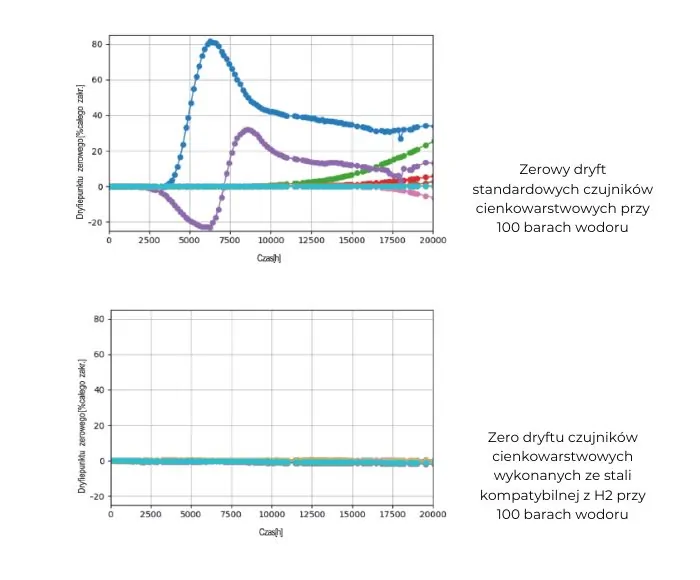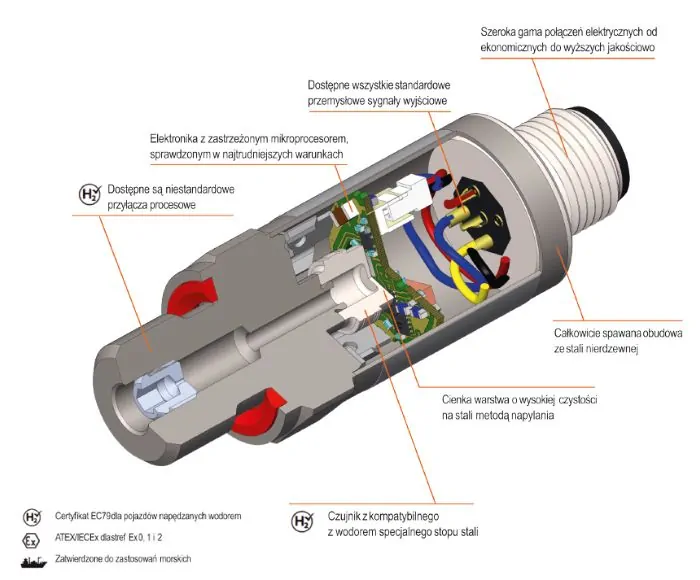20.12.2023
With the increasing spread of hydrogen as an energy carrier, the need for appropriate pressure transmitters is also growing. Although hydrogen has been used for years at low pressure in the chemical and process industries, new challenges arise in H2 mobility applications: measurement ranges exceeding 1000 bar, limited space and high costs for large batches require new, innovative sensor concepts.
The hydrogen molecule - as the smallest of all - has the property that, thanks to diffusion, it can penetrate the structure of many steels and other materials available on the market. It can penetrate the structure of the material or pass through it, or it can be a combination of these two effects. Hydrogen embrittlement is well known and is caused by the fact that penetrating hydrogen changes the structure of the steel. Permeation, the process of hydrogen sorption (absorption) at the membrane surface, diffusion through the membrane material and desorption at the rear, is not a problem in most applications, such as pressure vessels, because they have sufficiently large wall thicknesses. However, in the case of pressure sensors that have thin walls, hydrogen penetration through the measuring membrane may lead to reactions with the sensor elements.
In industrial hydrogen applications, almost exclusively pressure transmitters with piezoresistive sensors or thin-film sensors are used. Other types of sensors used in pressure transmitters are either technically unsuitable (e.g. ceramic sensors due to the high porosity of the material) or are too expensive.

In the case of a pressure transmitter with a piezoresistive sensor, the extremely small wall thickness of the separation membrane, only about 70 micrometers, may pose a problem when exposed to hydrogen. The separation membrane itself is standardly made of hydrogen-compatible AISI316L material, which makes it non-brittle. However, at higher pressures, hydrogen can diffuse through the thin separation membrane into the oil fill. Hydrogen dissolved in oil can form bubbles, which is expressed by a sudden and strong shift in the signal, which, depending on the pressure curve, may spontaneously disappear as soon as the bubble dissolves again. As a countermeasure, the separation membrane is covered with a gold coating on the hydrogen side, which acts as a sorption barrier. Tests by the Swiss manufacturer of pressure transducers, Trafag, show that this gold layer must have a certain minimum thickness in order to perform a protective function. The protective effect is reduced if the layer is too thin, if it is damaged by micro-scratches or if it has insufficient adhesion and the smallest bubbles caused by contamination during the galvanizing process.
On the other hand, thin-film-on-steel sensors used in pressure transmitters have a much thicker diaphragm. However, it is usually made of a material unsuitable for hydrogen (17-4PH or 1.4542), i.e. a high-performance martensitic steel with a rather low nickel content.
Austenitic steels with a nickel content above approximately 13 percent are considered suitable for use with hydrogen. Therefore, alternative steel alloys should be used. According to this principle, a high yield strength is required so that the membrane, and therefore the sputtered resistive bridges, can stretch so much that a useful signal is generated. Unfortunately, many H2-compatible steels, such as AISI316L, do not meet this requirement. If steel sensors with AISI31L diaphragms are used, they usually do not have a long-term stable sputtered resistance bridge, but have a coating that exhibits a greater change in resistance for the same stress, but is often more susceptible to signal drift.
A big challenge is to find appropriate steel alloys that are compatible with H2 and at the same time suitable for building thin-film sensors. For thin-film cells with sputtered resistors, there are certain high-nickel austenitic steel alloys that also have sufficient yield strength and are therefore suitable. However, for a sensor manufacturer, the difficulty with these steels is obtaining a material quality that allows for long-term stable, low-drift sensors. The critical parameters are usually the homogeneity of structure, alloy and heat treatment. Trafag's tests with its own sensors made of various alloys and those of competitors have shown that many of the solutions currently offered have significantly greater long-term drift than conventional air or oil sensors. Thanks to extensive experience in the production of pressure transmitters and sensors, years of intensive research and countless tests, Trafag has managed to develop a thin-film sensor made of hydrogen-compatible steel whose long-term stability is significantly better than most of its competitors.
The long-term stability of hydrogen pressure sensors is currently the main criterion for evaluating pressure transmitters. The design and size, electronics and mechanical construction are mostly taken from proven industrial pressure sensors and therefore almost always meet the requirements of hydrogen applications. Long-term sensor stability, meaning that measurement accuracy does not change or changes only slightly over the period of use, is critical especially in hydrogen applications. Poor long-term stability is primarily reflected in zero point drift, which means that the signal no longer shows zero when there is no pressure.
Fragility, which is often mentioned in the literature as the biggest problem, did not occur in the case of Trafag sensors during the tests. Crack tests on standard sensors, i.e. those made of material incompatible with hydrogen, did not show any measurable drop in burst pressure even after prolonged use in a hydrogen environment, although the signals already showed enormous drift.
During operation, three parameters in particular have a large impact on the long-term stability of hydrogen pressure sensors:
• Pressure: The higher the pressure, the stronger and faster the diffusion effect. Alternating load cycles can also accelerate this effect because the movement of the structure facilitates the mobility of the permeated hydrogen.
• Temperature: The higher the temperature, the faster the harmful effects of hydrogen become visible. Friability decreases again from about 60°C, but diffusion continues to increase.
• Timing: The duration of exposure to hydrogen is critical. Signal deviations become visible only after some time and are not linear.
While the effects of pressure and temperature are obvious and are taken into account in the assessment in the test criteria, time is often not sufficiently taken into account. Trafag tests have shown that sensors made from unsuitable standard membrane steel sometimes exhibit characteristic zero-point drift effects after 10,000 hours of hydrogen exposure, and that a large spread occurs when zero-point drift actually begins. Many of the drift effects are reversible for steel sensors: Once the sensor is no longer exposed to hydrogen, the hydrogen concentration slowly decreases - at higher temperatures (above about 80°C) it drops relatively quickly.
The key element of the pressure transmitter from the Swiss manufacturer Trafag are pressure sensors based on thin-film-on-steel technology (fully welded structure without O-ring). The sensor technology comes from Trafag's own production and has been developed in-house along with a customized ASIC (application-specific microchip) for processing sensor signals. As a result, the pressure sensor and electronics work together perfectly. This allows the sensor in the Trafag pressure transmitter to achieve an exceptional level of long-term stability and reliability, even under the most adverse environmental conditions.
To meet hydrogen-specific pressure measurement requirements, such as strength and permeability, Trafag has designed a special steel alloy for pressure sensors in contact with hydrogen. This specific steel alloy, nitrogen-reinforced austenitic steel, is both hydrogen compatible and possesses all the material properties necessary to build robust, accurate and long-term stable pressure sensors.

Poltraf's offer includes NHT8250, EHI8280 and EXNT 8292 hydrogen pressure transmitters. The EXNT8292 pressure transmitter is ATEX and IECEx certified and is also approved for marine applications. Each of these pressure transmitters is also EC79/2009 certified. This certificate means that the pressure transducers indicated above meet the general requirements of hydrogen components and systems used in hydrogen-powered motor vehicles in accordance with Regulation (EC) No. 79/2009 of the European Parliament and of the Council of 14 January 2009. The pressure transducers can therefore be used in vehicles with hydrogen drive. Trafag does not have to use gold in its pressure transmitters, which means that the pressure transmitters from the Swiss manufacturer are also attractively priced.
29.05.2025
The International Trade Fair of Machines and Devices for Water Supply and Sewage WOD-KAN took place on 20-22 May 2025. This is the 31st edition of the trade fair, which attracted many exhibitors and people who wanted to familiarize themselves with new devices and technologies dedicated to the water and sewage industry to Bydgoszcz.

05.05.2025
The Trade Fair of Machines and Devices for Water and Sewage Systems WOD-KAN will begin in Bydgoszcz in just 3 weeks. The water and sewage industry is an important recipient of our measuring devices, which is why we cannot miss the 31st edition of the Bydgoszcz trade fair.

14.11.2025
We have already delivered nearly 1,000 electromagnetic flowmeters to our customers. The experience we have gained has shown us the most common problems encountered by designers and installers of these devices. In the previous article, we focused on what to consider when selecting an electromagnetic flowmeter. In this article, we will address the proper installation of an electromagnetic flowmeter.

We are a representative and distributor in Poland of the following brands: